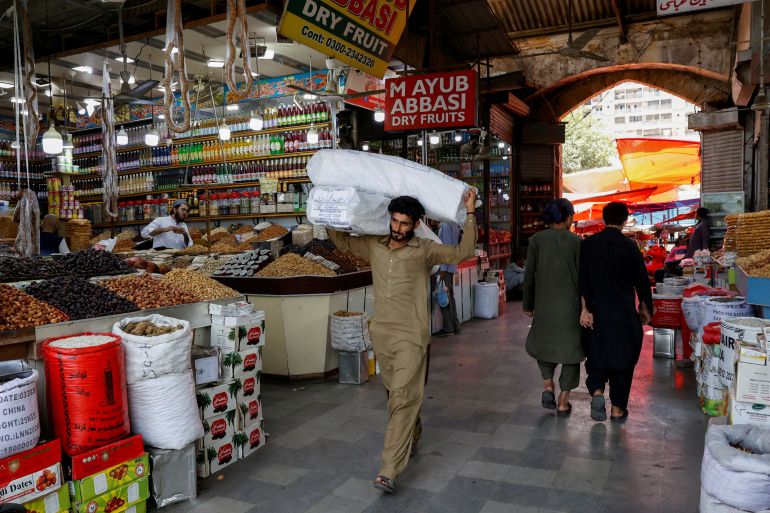IMF loan offers Pakistan relief but long-term reforms remain a challenge
The $7bn loan is a lifeline for Pakistan’s struggling economy, but experts say the country needs fundamental changes.
Pakistan has secured a 37-month-long, $7bn loan from the IMF but analysts say the government must take steps to protect the poor [Akhtar Soomro/Reuters]By Abid HussainPublished On 26 Sep 202426 Sep 2024
Islamabad, Pakistan – After days of uncertainty, the International Monetary Fund (IMF) approved a $7bn loan programme for Pakistan on Wednesday, a move analysts welcomed for its potential to stabilise the South Asian nation’s economy. However, they also cautioned that it places significant responsibility on the government to pursue reforms for long-term stability.
Pakistan had reached a staff-level agreement with the IMF in July for the 37-month loan – its 25th since 1958 – but delays in securing a final approval created market uncertainty.
Prime Minister Shehbaz Sharif, currently attending the United Nations General Assembly in New York, hailed the decision, insisting that the government was committed to implementing reforms demanded by the deal. He said he also hoped that this would be “Pakistan’s last IMF programme”.
Economic analyst Uzair Younus said that while Pakistan has stabilised after a prolonged period of volatility, much work needs to be done.
“The agreement, in the short term, will create space for the government, but if the medium-term outlook is to improve, then the government needs to pursue structural reforms that create both fiscal space for Islamabad and assuage concerns about debt sustainability,” the Washington, DC-based analyst told Al Jazeera.
Pakistan’s debt, which poses the biggest strain on its $350bn economy, requires $90bn in repayments over the next three years, with the next major tranche due in December.
Foreign reserves with the central bank currently stand at $9.5bn, sufficient to cover just over two months of imports.
Sajid Amin Javed, a senior economist at the Sustainable Development Policy Institute (SDPI) in Islamabad, said that the loan primarily aims to ease Pakistan’s debt repayments.
“While much needed, a programme built around rollovers, expensive borrowing from commercial banks to fill in financing gaps is hardly to bring any sustainable solutions to Pakistan’s economic and financial challenges,” he added.
Pakistan is the IMF’s fifth-largest debtor, owing more than $6bn as of September 25, according to the lender’s data, after Argentina, Egypt, Ukraine and Ecuador.
Analysts say one challenge before Pakistan will be to build a broad political consensus around the reforms needed under the IMF deal: including taxes, raising energy tariffs and allowing market forces to determine the Pakistani rupee’s value.
“Political stability will define the fate of the programme and the economy. Implementation of the reforms agenda outlined in this programme, such as no subsidies from provinces, taxes on the agriculture sector, privatisation – they all demand a very high level of commitment from different political parties ruling in respective provinces,” Javed said.
Over the last 30 months, Pakistan has faced political turbulence, including the removal of former Prime Minister Imran Khan through a no-confidence vote in 2022. Under Khan, the Pakistani government faced accusations of breaching the previous IMF agreement by drastically cutting fuel prices.
Government policies, including artificially protecting the value of the rupee, as well as a catastrophic flood in the country in late 2022 meant that by May 2023, inflation soared to as high as 38 percent, while foreign reserves fell to $3bn.
Pakistan, under the first tenure of Sharif as prime minister, narrowly avoided default last year after securing a nine-month $3bn standby arrangement with the IMF.
The 2024 election, which was marred by vote-rigging allegations, resulted in a coalition government led by Sharif’s Pakistan Muslim League-Nawaz (PML-N) but heavily reliant on allied parties.
Sharif, in his current stint, picked Muhammad Aurangzeb – a political outsider and veteran banker – as his finance minister, tasked with overseeing the implementation of the standby arrangement. The term of that agreement ended in April, and by August 2024, inflation had dropped to 9.6 percent, its lowest since October 2021, aided by falling global fuel prices.
However, Ali Hasanain, an associate professor of economics at Lahore University of Management Sciences, expressed scepticism about the reforms.
“Without addressing fundamental dysfunctions, the country will almost certainly falter. Long-term possibilities are immense, but they remain untapped,” Hasanain said, referring to the political schisms in the country and the risks they pose to a unified approach towards reforms.
Javed echoed this sentiment, emphasising that the ruling coalition must “rise above politics” to ensure the programme’s success.
“It will be important to see to what extent the ruling coalition shares the responsibility and burden of the programme,” he said. “A politics-led approach, as we have seen in the last seven and half decades, can jeopardise this programme,” Javed added.
While some argue that Pakistan should seek to restructure its debt, Younus believes the external debt burden is manageable, “provided Pakistan’s ruling elites pursue a sustained roadmap of structural reforms that bolsters creditor confidence”.
However, Javed warned that without such reforms, the country’s economy could face a repeat of the crisis that engulfed the country in 2022 and 2023, which would harm the populace.
“The government needs to protect people from side-effects of stabilisation through creating livelihood opportunities in agriculture, and other similar sectors, expanding social protection and safety nets and better administration and governance at a local level,” he said.
“Stabilisation should not come at the cost of poor people.”
